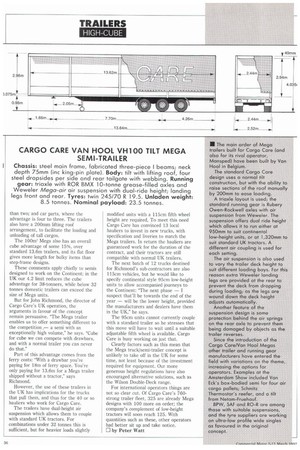CARGO CARE VAN HOOL VH100 TILT MEGA SEMI-TRAILER
Page 38

If you've noticed an error in this article please click here to report it so we can fix it.
Chassis: steel main frame, fabricated three-piece I beams; neck depth 75mm (inc king-pin plate). Body: tilt with lifting roof, four steel dropsides per side and rear tailgate with webbing. Running gear: triaxle with ROR BMX 10-tonne grease-filled axles and Weweler Mega-air air suspension with dual-ride height; landing legs front and rear. Tyres: twin 245/70 R 19.5. Unladen weight: 8.5 tonnes. Nominal payload: 23.5 tonnes.
than two; and car parts, where the advantage is four to three. The trailers also have a 200mm lifting roof arrangement, to facilitate the loading and unloading of tall cargos.
The 100m3 Mega also has an overall cube advantage of some 15%, over standard 13.6m trailers, and its flat floor gives more length for bulky items than step-frame designs.
These comments apply chiefly to semis designed to work on the Continent; in the UK our 4.2 limit reduces the cube advantage for 38-tonners, while below 32 tonnes domestic trailers can exceed the size of Mega units.
But for John Richmond, the director of Cargo Care's UK operation, the arguments in favour of the concept remain persuasive. "The Mega trailer enables us to offer something different to
the competition a semi with an exceptionally high volume," he says. "Cube for cube we can compete with drawbars, and with a normal trailer you can never do that."
Part of this advantage comes from the ferry costs: "With a drawbar you're paying for 18m of ferry space. You're only paying for 13.6m for a Mega trailer shipped without a tractor," says Richmond.
However, the use of these trailers in the UK has implications for the trucks that pull them, and thus for the 40 or so hauliers who work for Cargo Care.
The trailers have dual-height air suspension which allows them to couple with standard UK tractors. For combinations under 32 tonnes this is sufficient, but for heavier loads slightly modified units with a 115cm fifth wheel height are required, To meet this need Cargo Care has convinced 13 local hauliers to invest in new trucks, with specification and liveries to match the Mega trailers. In return the hauliers are guaranteed work for the duration of the contract, and their tractors are still compatible with normal UK trailers.
The next batch of 12 trucks destined for Richmond's sub-contractors are also 115cm vehicles, but he would like to specify continental style 95cm low-height units to allow accompanied journeys to the Continent: "The next phase — I suspect that'll be towards the end of the year — will be the lower height, provided the manufacturers and dealers have them in the UK," he says.
The 95cm units cannot currently couple with a standard trailer so he stresses that this move will have to wait until a suitable adjustable fifth wheel is available. Cargo Care is busy working on just that.
Clearly factors such as this mean that the Mega truck/semi-trailer concept is unlikely to take off in the UK for some time, not least because of the investment required for equipment. Our more generous height regulations have also encouraged alternative solutions, such as the Wilson Double-Deck range.
For international operators things are not so clear cut. Of Cargo Care's 760strong trailer fleet, 325 are already Mega designs with 100 more on order; the company's complement of low-height tractors will soon reach 125. With quantities such as these, other operators had better sit up and take notice.
0 by Peter Watt












































































































